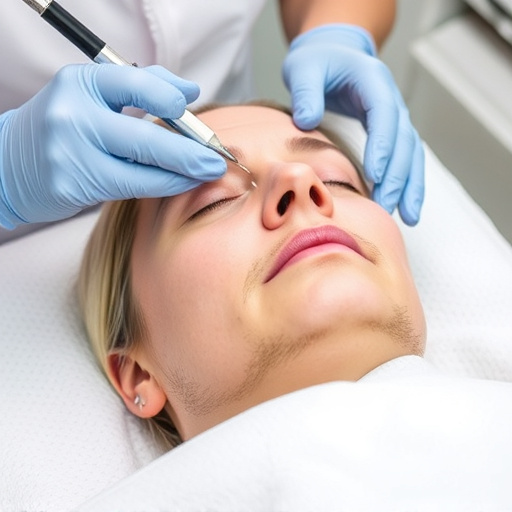Melasma, a hormonal skin condition with dark patches, improves with personalized skincare, spa treatments like chemical peels, and laser therapy. By 2025, advanced topical treatments using hydroquinone and retinoids, along with microneedling, offer more effective melasma treatment options tailored by dermatologists.
Melasma, characterized by dark patches on the face, remains a common skin concern despite its mysterious causes. As we step into 2025, advancements in dermatology offer hope for clearer complexions. This article explores effective melasma treatment options, from topical creams and serums to advanced in-office procedures like lasers and light therapies. Understanding both traditional and modern approaches is key to selecting the best course of action for achieving radiant, melasma-free skin.
- Understanding Melasma: Causes and Diagnosis
- Topical Treatments: Creams and Serums for Clearer Skin
- Advanced Therapies: Laser, Light, and In-Office Procedures
Understanding Melasma: Causes and Diagnosis

Melasma is a common yet often misunderstood skin condition characterized by dark patches on the face, typically affecting women during pregnancy or as a result of hormonal fluctuations. While it may be temporarily managed through lifestyle changes and over-the-counter products, many seek more effective melasma treatment options. Understanding the causes is crucial in diagnosing the condition accurately. Hormonal imbalances, including those occurring during pregnancy or due to contraceptive pills, are major contributors. Additionally, sun exposure plays a significant role, as UV rays can trigger melanin production, leading to darker patches.
Diagnosis often involves a comprehensive skin examination and, in some cases, medical imaging to rule out other conditions. Dermatologists may also use specialized tools to assess the depth of pigment changes, aiding in tailoring melasma treatment plans. Personalized skincare approaches, combined with medical spa services offering advanced treatments like chemical peels or targeted laser therapy, can offer promising results for those seeking effective skin rejuvenation.
Topical Treatments: Creams and Serums for Clearer Skin

Melasma, characterized by dark patches on the face, often presents a challenge for skincare enthusiasts. However, the year 2025 brings an array of effective topical treatments that offer hope for clearer, more even skin. These creams and serums are designed to address the root causes of melasma, targeting hyperpigmentation with potent ingredients.
One popular approach involves using hydroquinone, a well-known agent for fading dark spots. When applied topically, it inhibits tyrosinase, an enzyme responsible for melanin production. Additionally, retinoids, derivatives of vitamin A, are widely used in non-surgical treatments to promote skin cell turnover and reduce the appearance of wrinkles and hyperpigmentation associated with melasma. Many medical spa services now incorporate these ingredients into customized skincare routines, offering tailored solutions for individuals seeking effective melasma treatment.
Advanced Therapies: Laser, Light, and In-Office Procedures

In the realm of melasma treatment, advancements in recent years have brought about a plethora of options that promise effective results. Among these, advanced therapies such as laser, light, and in-office procedures stand out as game changers in 2025. These innovative approaches leverage the power of technology to target pigmentation issues with precision, offering hope for those seeking to restore their skin health.
One notable therapy is microneedling, which involves using tiny needles to create controlled micro-injuries in the skin. This process stimulates collagen production and enhances skin absorption of topical treatments, making it an effective complement to other melasma treatments. Professional skincare experts often incorporate these advanced therapies into comprehensive routines, ensuring that each patient receives tailored care for their specific skin health needs.
By 2025, the landscape of melasma treatment has evolved significantly. While understanding causes and diagnosis remains crucial, advancements in topical treatments, including innovative creams and serums, offer promising results. Additionally, advanced therapies like laser, light, and in-office procedures provide effective alternatives for those seeking clearer skin. Remember that, specific treatment options depend on individual needs, and consulting a dermatologist is essential for tailoring a successful melasma management strategy.














